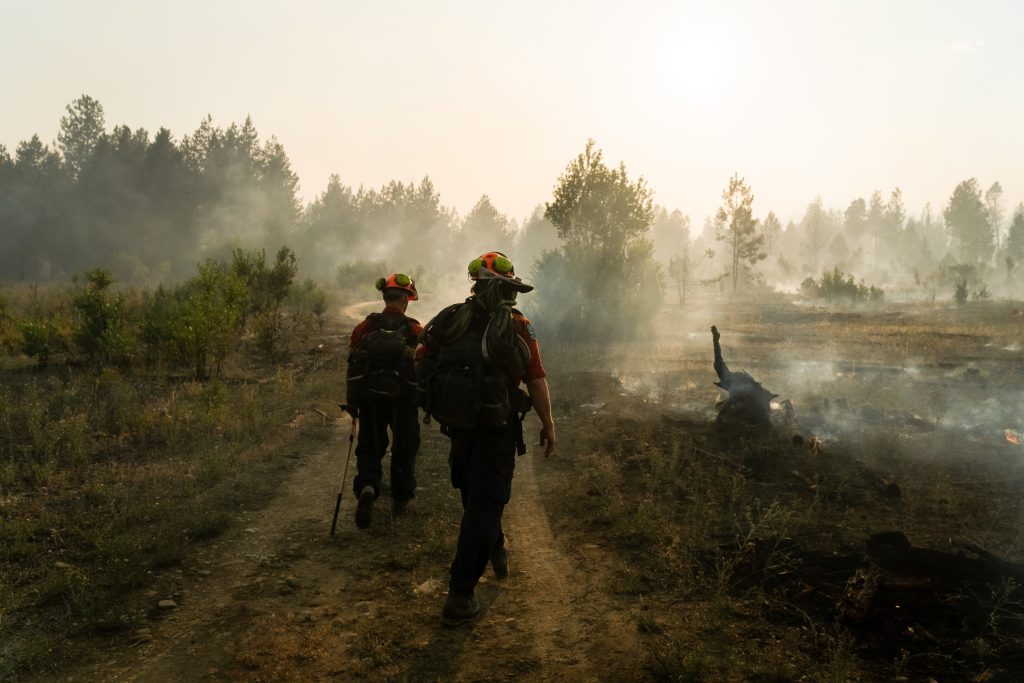Fall 2023: persistent drought
The 2023 wildfire season was characterized by ongoing drought impacts, extreme fire behaviour and rapid wildfire growth and concluded with widespread drought across most of B.C.
Once the ground is frozen and forests become dormant, the ability for the soil and vegetation to absorb water becomes limited. For this reason snow and rain received over the winter has a limited impact in sub-zero temperatures.
The exception to this pattern is the Coastal Fire Centre, which received much-needed rain before temperatures dropped below zero.

Winter 2024: wildfire activity
Since January 1, there have been eight new wildfire starts. All of these incidents are Out, Under Control or Being Held.
The majority of human-caused wildfires in B.C. happen in the spring and fall. Shoulder seasons require the most vigilance from the public in terms of open-fire safety.
Numerous overwintering wildfires have smouldered beneath the winter snow cover. These wildfires are under close observation, as potential for increased fire activity increases when snow melts, the air becomes drier and moderate winds occur.
Overwintering wildfires, which are not a new phenomenon, are wildfires that burn overwinter, often underground, and have the potential to resurface as conditions warm and dry. All active overwintering fires in B.C. are ‘Under Control’, meaning suppression efforts have ensured they will not spread any further. Smoke and heat signatures observed on these wildfires are within the existing fire perimeter, and do not represent new growth.
Several factors influence the likelihood and occurrence of overwintering fires. A major one is the Drought Code (DC), which is the average moisture content of deep, compact fuels. When these fuels are exceptionally dry, wildfires smoulder in deep duff layers and within large logs, remaining active underground with the potential to resurface come spring.

Spring 2024: outlook
The current long-range forecasts suggest a high potential for an active spring wildfire season in British Columbia. Once fuels and forests are snow-free, elevated fire activity is anticipated this spring. A spring wildfire season is common in British Columbia.
While recent snowfall may seem beneficial, its impact on the upcoming wildfire season is expected to be minimal due to sublimation (solid to vapour) and the dry nature of snow in Interior regions. However, the presence of snow can temporarily prevent further drying of fuels underneath. Once the snow melts, fine fuels have the potential to dry out very quickly, particularly in windy conditions
As of February 1, the BC River Forecast Centre reported an extremely low provincial snowpack, averaging 61per cent of normal across British Columbia. The low snowpack will limit surface runoff, stream flows, and fuel moisture recharge which could limit drought recovery into summer 2024.
Watch Neal McLoughlin, Superintendent of Predictive Services for the BC Wildfire Service deliver a brief presentation on the spring wildfire outlook. This spring readiness call also includes presentations by Minister of Emergency Management and Climate Readiness, Bowinn Ma; Bruce Ralston, Minister of Forests, and technical specialists from Environment and Climate Change Canada and the River Forecast Centre. It includes information on the spring snowpack, freshet and flood season.
Summer 2024: long-range forecast
May and June are typically the rainiest months in the B.C. Interior. The amount and duration of rain events during this period influences the length and intensity of the core wildfire season. Conditions have the potential to improve if widespread, continuous rain is received this spring. It is too early to tell though; long-range weather forecasts, especially for precipitation, are unreliable. However, meteorologists are skeptical that sufficient rainfall will occur. Until we experience significant and prolonged rains, the elevated drought will continue to support the potential for easy ignition and rapid wildfire growth

Prescribed fire
Prescribed fire is the planned and intentional use of fire on a specific land area. It is one of the most ecologically appropriate and relatively efficient means for achieving a range of objectives. These objectives can include habitat enhancement, preparation for tree planting or disease eradication.
Prescribed fire can also contribute to achieving air quality and climate action targets by preventing large, intense wildfires and replacing them with more frequent, well-timed, well-planned low-intensity fires.
These fires can take many months to plan and are managed to minimize the chance of escape and smoke impacts while maximizing the benefits to the site.
Visit PrescribedFire.ca to learn more.
